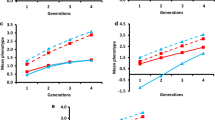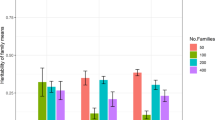Abstract
Genetic hazards associated with the stocking of fish juveniles produced in hatcheries were studied with simple mathematical models. Domestication is the process of acquiring a genetic characteristics that are advantageous in a hatchery environment but that are disadvantageous in a natural environment due to the selection pressure in the hatchery differing from that in the natural environment. Conditions for the propagation of mutants enhancing domestication were obtained for a variety of stocking strategies specified by parameters related to hatchery productivity and kind of brood stock used. By using this, the possibility of reducing the risk of domestication was studied. As a means of reducing the risk, selective use of wild-born individuals for brood stock was considered. The effectiveness of this was analyzed for both the cases where all brood stock is collected from the wild, and the male brood stock is collected from the wild and the female brood stock is born and reared in a hatchery. We also estimate how much hatchery release can be increased without increasing the risk by employing these means. It is concluded that the use of only male brood stock from the wild is not very effective in reducing the risk of domestication. Further, it is concluded that selective use of the wild-born individuals of both sexes for brood stock is highly desirable if the contribution of released individuals to the natural reproduction is high. In other words, substantial increase of hatchery release may be possible while keeping risk at a level comparable to that under moderate hatchery release, if it is accompanied by the selective use of wild-born individuals for brood stock.
Similar content being viewed by others
References
Allendorf F. W. (1993) Delay of adaptation to captive breeding by equalizing family size.Conservation Biology 7: 416–419.
Allendorf F. W. and N. Ryman (1987) Genetic management of hatchery stocks. pp. 141–160.In N. Ryman and F. Utter (eds.)Population genetics and fisheries management. University of Washington Press, Seattle and London.
Blankenship H. L. (1990) Effects of time and fish size on coded wire tag loss from chinook and coho salmon.American Fisheries Society Symposium 7: 237–243.
Busack G. A. and K. P. Currens (1995) Genetic risks and hazards in hatchery operations: fundamental concept and issues.American Fisheries Society Symposium 15: 71–80.
Caballero, A., M. A. Toro and C. López-Fanjul (1991) The response to artificial selection from new mutations in Dolosophila melanogaster.Genetics 127:89–102.
Campton, D. E. (1995) Genetic effects of hatchery fish on wild populations of Pacific salmon and steelhead: what do we really know?American Fisheries Society Symposium 15: 337–353.
Couvet, D. and K. Ronfort (1994) Mutation load depending on variance in reproductive success and mating system. pp. 55–68.In V. Loeschcke, J. Tomiuk and S. K. Jain (eds.)Conservation genetics. Birkhäuser Verlag, Basel, Switzerland.
Cuenco, M. L. (1994) A model of an internally supplemented population.Transactions of the American Fisheries Society 123: 277–288.
Cuenco, M. L., T. W. H. Backman and P. R. Mundy (1993) The use of supplementation to aid in natural stock restoration. pp. 269–293.In J. G. Cloud and G. H. Thorgaard (eds.)Genetic conservation of salmonid fishes. Plenum Press, New York.
Hard, J. J., R. P. Jones, Jr., M. R. Delarm and R. S. Waples (1992) Pacific salmon and artificial propagation under the endangered species act.NOAA Technical Memorandum NMFS-NWFSC-2, Northwest Fisheries Science Center,Seattle.
Iwamoto, A., H. Okouchi, T. Tsuzaki, T. Fukunaga and S. Kitada (1998) Stocking effectiveness of flounderParalichthys olivaceus in Miyako Bay evaluated by a fish market census.Nippon Suisan Gakkaishi 64: 830–840 (in Japanese).
Kitada, S. (in press) Effectiveness of Japan’s stock enhancement program: Current perspective.In B. R. Howell, E. Moksness and T. Svåsand (eds.)Stock enhancement and sea ranching. Fishing News Books, Oxford.
Ludwig, B. (1995) British Columbia’s trout hatchery program and the stocking policies that guide it.American Fisheries Society Symposium 15: 139–143.
May, R. M. (1974)Stability and complexity in model ecosystem, 2nd edn. Princeton University Press, Princeton.
Mesa, M. G. (1991) Variation in feeding, aggression, and position choice between hatchery and wild cutthroat trout in an artificial stream.Transactions of the American Fisheries Society 120: 723–727.
Nakamura, R. and H. Kuwada (1994) Detection of alizarine complexone label in scales in the mass marking system of larval and juvenile fish.Saibai Giken 23: 53–60 (in Japanese).
Perry, E. A. (1995) Salmon stock restoration and enhancement: strategies and experiences in British Columbia.American Fisheries Society Symposium 15: 152–160.
Reisenbichler, R. R. and J. D. Mclntyre (1977) Genetic differences in growth and survival of juvenile hatchery and wild steelhead trout, Salmo gairdneri.Journal of Fisheries Research Board of Canada 34: 123–128.
Ryman, N. and L. Laikre (1991) Effects of supportive breeding on the genetically effective population size.Conservation Biology 5: 325–329.
Ryman, N., P. E. Jorde and L. Laikre (1995) Supportive breeding and variance effective population size.Conservation Biology 9: 1619–1628.
Schramm, H. L. and R. G. Piper (eds.) (1995)Uses and effects of cultured fishes in aquatic ecosystems.American Fisheries Society Symposium,15. American Fisheries Society, Bethesda.
Schwartzberg, M. and J. K. Fryer (1993) Identification of hatchery and naturally spawning stocks of Columbia basin spring chinook salmon by scale pattern analysis.North American Journal of Fisheries Management 13: 263–271.
Seelbach, P. W. and G. E. Whelan (1988) Identification and contribution of wild and hatchery steelhead stocks in Lake Michigan tributaries.Transactions of the American Fisheries Society 117: 444–451.
Swain, D. P. and B. E. Riddel (1990) Variation in agonistic behavior between newly emerged juveniles from hatchery and wild population of coho salmon, Oncorhynchus kisutch.Canadian Journal of Fisheries and Aquatic Sciences 47: 566–571.
Thorpe, J., G. Gall,J. Lannan and C. Nash(eds.) (1995)Conservation of fish and shellfish resources: managing diversity. Academic Press, London.
Unwin, M. J. and D. H. Lucas (1993) Scale characteristics of wild and hatchery chinook salmon(Oncorhynchus tchawytscha) in the Ralaia River, New Zealand, and their use in stock identification.Canadian Journal of Fisheries and Aquatic Sciences 50:2475–2484.
Waples, R. S. and C. Do (1994) Genetic risk associated with supplementation of pacific salmonids: Captive brood stock program.Canadian Journal of Fisheries and Aquatic Science 51 (Suppl. 1): 310–329.
Watanabe, T. (1985) Importance of the study of broodstock nutrition for further development of aquaculture. pp. 395–414.In C. B. Cowey, A. M. Mackie and J. G. Bell (eds.)Proceeding of international symposium on nutrition and feeding in fish. Academic Press, London.
Yanagisawa, T. (1995) Practical seed production technology of black abalone. pp. 125–153.In Japan Sea Farming Association (ed.)Seed production technology of Abalone. Japan Sea Farming Association, Tokyo (in Japanese).
Yoshizawa, K. (1998) Hatchery production of ayu and the conservation of genetic diversity.Kaiyo 30: 229–232 (in Japanese).
Author information
Authors and Affiliations
Corresponding author
Rights and permissions
About this article
Cite this article
Harada, Y., Yokota, M. & Iizuka, M. Genetic risk of domestication in artificial fish stocking and its possible reduction. Res Popul Ecol 40, 311–324 (1998). https://doi.org/10.1007/BF02763463
Received:
Accepted:
Issue Date:
DOI: https://doi.org/10.1007/BF02763463




